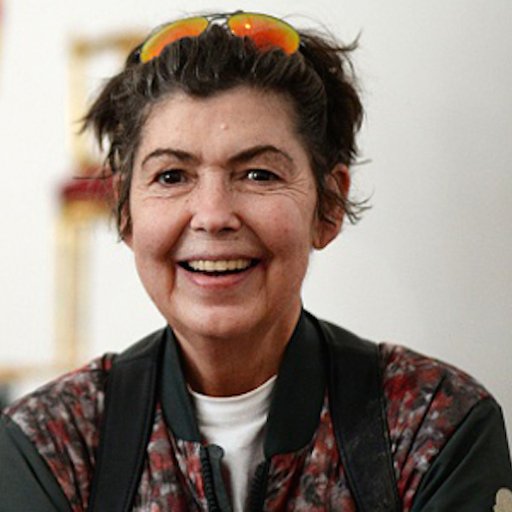Stephan Balkenhol
Stephan Balkenhol has redefined the human form in sculpture, merging the attention to formal details supported by the Minimalists with the open-ended abstraction of Conceptual artists. His mentors in the Hamburg School in the late 1970s, including Nam June Paik and Sigmar Polke, were a huge influence on his practice. His portrayal of the naked figure in the early 1980s was followed by an integration of animals and hybrid creatures in the 1990s. His figures, from Barbie doll to life-sized and larger, are crudely carved out of a single block of wood with a chisel and hammer. They proudly display marks of their making, knots, splinters, and shavings. The figures are painted to accentuate anatomy, timeless clothing and expressionless, serene faces. Balkenhol has also generated small scenes for his figures by adding architectural elements. Relief portraits and landscapes, some of which are paired with the three-dimensional figures while others, carved into blocks of wood or handmade screens, are similarly unwavering in their neutrality. The works are physically reminiscent of folk art, yet unattached to allegory or narrative. Balkenhol reinvigorated the figure as a form that can acquire meaning, like that of a puppet or mannequin, without necessarily pushing an agenda. …
Stephan Balkenhol has redefined the human form in sculpture, merging the attention to formal details supported by the Minimalists with the open-ended abstraction of Conceptual artists. His mentors in the Hamburg School in the late 1970s, including Nam June Paik and Sigmar Polke, were a huge influence on his practice. His portrayal of the naked figure in the early 1980s was followed by an integration of animals and hybrid creatures in the 1990s. His figures, from Barbie doll to life-sized and larger, are crudely carved out of a single block of wood with a chisel and hammer. They proudly display marks of their making, knots, splinters, and shavings. The figures are painted to accentuate anatomy, timeless clothing and expressionless, serene faces. Balkenhol has also generated small scenes for his figures by adding architectural elements. Relief portraits and landscapes, some of which are paired with the three-dimensional figures while others, carved into blocks of wood or handmade screens, are similarly unwavering in their neutrality. The works are physically reminiscent of folk art, yet unattached to allegory or narrative. Balkenhol reinvigorated the figure as a form that can acquire meaning, like that of a puppet or mannequin, without necessarily pushing an agenda.
Balkenhol has exhibited widely around the world. Solo exhibitions of his work have been installed at the Landes Museum, Linz, Austria, Kunstmuseum Ravensburg, Germany, Musée de Grenoble, France, National Museum of Contemporary Art, Osaka, Tel Aviv Museum of Art, Israel, Sprengel Museum, Hannover, Germany, and the Hirschhorn Museum and Sculpture Garden, Washington, D.C, among others. He has also participated in group exhibitions at the Ellipse Foundation Contemporary Art, Lisbon, Museum der Moderne Salzburg Mönchsberg, Austria, and the Institute of Contemporary Art, Philadelphia, among many others. The artist has regularly been commissioned for public artworks since the 1980s, many of which are in bronze or steel. Some of the locations hosting Balkenhol’s sculptures are Blackfriars Bridge in London, and the entrance to the Hamburg Zoo in Germany.
Art Institute of Chicago, Chicago, Illinois
The Broad Art Foundation, Santa Monica, California
Irish Museum of Modern Art, Dublin, Ireland
Kunsthalle Hamburg, Hamburg, Germany
Los Angeles County Museum of Art, California
MARCA Museum, Cantanzaro, Italy
Museum für Moderne Kunst, Frankfurt, Germany
Museu Berardo, Lisbon, Portugal
Museum De Paviljoens, Almere, The Netherlands
Musée Cantonal des Beaux Arts, Lausanne, Switzerland
Musée de Marseille, Marseille, France
Musée des Beaux Arts de Montréal, Quebec, Canada
Museum Africa, Johannesburg, South Africa
Neues Museum, Nürnberg, Germany
The National Museum of Art, Osaka, Japan
Ordos Art Museum, Inner Mongolia, China
Peggy Guggenheim, Venice, Italy
Scottish National Gallery of Modern Art, Edinburgh, Scotland
Smithsonian Institution, Hirshhorn Museum and Sculpture Garden, Washington, D.C.
Stephen Friedman Gallery, London, United Kingdom
Galerie Thaddaeus Ropac, Paris, France/Salzburg, Austria
John Berggruen Gallery, San Francisco, California
Deweer Gallery, Otegem, Belgium





